LAWH-I QINĀ'
لوح قناء
(THE TABLET OF THE VEIL)
an
Epistle to Baha'-Allah to the Kirmani Shaykhi leader

Hajji Mirza Muhammad Karim Khan Kirmani
(1225-1288 AH= 1810-1871 CE)
Stephen N. Lambden 1983 -under revision and completion 2017+2022.
Last updated 07-08-2017+ 19-02-2022 - IN PROGRESS
Introduction.
Hajjī Mīrzā Muhammad Karīm Khān Kirmānī (1810-1871) came to be regarded by a proportion of the Shaykhī admirers or followers of Shaykh Aḥmad al-Ahsā'ī (d. 1243/1826) and his successor, the second Shaykhī leader Sayyid Kazim Rashtī (who died intestate on the last day of 1843 or first day of 1844 / 9th Dhu'l-Hijja 1259) and who did not become Bābīs, as the first Kirmani (or third) Shaykhi leader. The Lawḥ-i Qinā' (`Tablet of the Veil’) of Bahā’-Allāh is primarily addressed to this polymathic and polemical opponent of the Bābī‑ Bahā’ī religions, the Kirmani Shaykhī leader Hajji Mirza Muhammad Karīm Khān Kirmānī (d.1871). The important text was most probably written sometime between c.1869‑and 1872 CE.
Mss. and printed texts.
The text of the Lawḥ-i Qinā' has been printed several times, most importantly in Majmu`a-yi alwāḥ i mubāraka (see PDf above). It opens with a neo-basmala with follows with an address to the first Kirmani Shaykhi leader - the third after Shaykh Ahmad (d. 1826) and Sayyid Kazim Rashti (d.1843) - Hajjī Mīrzā Muhammad Karīm Khān Kirmānī (1810-1871).
Mss and printed texts of the Arabic and Persian scriptural `Tablet of the Veil' can be located in, for example,
- MS. in INBMC
- Iqtidarat wa chand Lawh-i digar [np.nd.[ Bombay 1310.AH/ 1892-3] pp.191-212. PDf. Iqtidarat - Lawh-i Qina'.pdf
- Majmū`a-yi alwāh-I mubāraka [MAM] ... Cairo,1920; rep. Wilmette, Ilinois: BPT., 1978, pp. 67-87. PDf. Lawh-i Qina'.pdf
Select references to the Lawḥ-i Qinā'.
Ishraq Khavari, Ganj-i shayigan, p.186.
The opening words of the Lawḥ-i qinā' (The Tablet of the Veil):
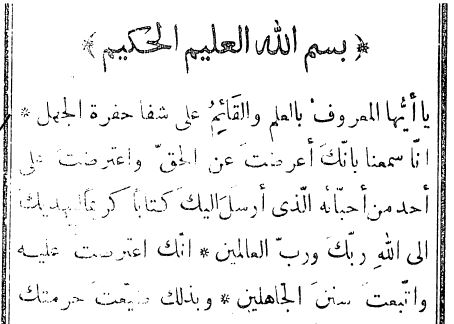
Opening lines as printed in Majmū`a-yi alwāh-i mubāraka... (Cairo), 67.
Lambden Translation (MAM:67ff):
[0]
In the Name of God, the All-Knowing, the All-Wise.
[I]
[1]
O thou [Karīm Khān Kirmānī] who hath a reputation for knowledge but is actually one standing at the brink of the abyss of ignorance. We have heard that thou became acquainted with the Truth-True One (al-haqq) [the Bab] yet turned aside from one of His beloved ones [= Quddus] who delivered unto thee a Noble Communication (kitab an karim an) [a letter of the Bab] in order to facilitate thy guidance unto God, thy Lord and the Lord of all the worlds. Thou turned aside from him and followed after the pathways of the ignorant ones (al-jahilin).
Lawḥ-i qinā' (The Tablet of the Veil) conclusion.
The Lawḥ-i Qinā' concludes as follows with reference to a complex work of Shaykh Ahmad which was previously brought to him in Iraq (between 1953 and 1863) by a certain Mirza Husayn Qummi and on which he had declined to write a tafsir or commentary.
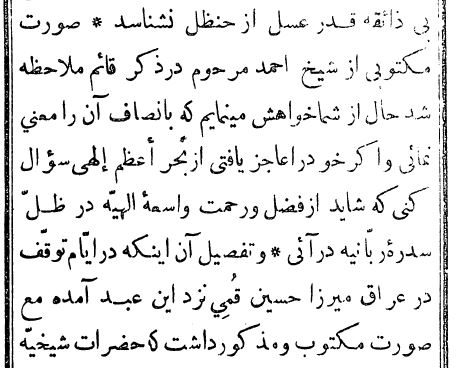
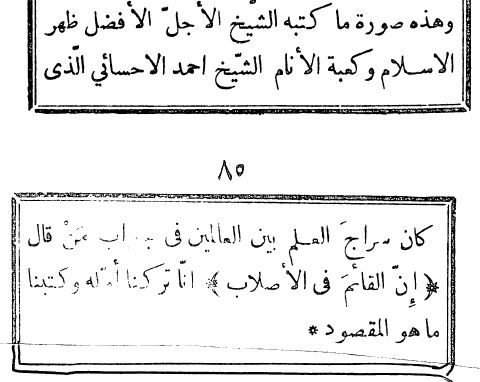
Concluding lines before the appendix relating to Shaykh Ahmad as printed in Majmū`a-yi alwāh-i mubāraka... (Cairo), pp.84-5.
The Supplementary Final section of the Lawh-i Qina' as printed in Iqtidarat, pp. 210-212 and Majmu`ah Alwah-i Mubaraka [MAM] pp. 85-87. Shaykh Ahmad ibn Zayn al-Din al-Ahsa'i (1241/1826) and the sirr al‑tankīs li‑ramz al‑ra`īs (" The Mystery of the Reversal by virtue of the enigma of the Ruler".
In the Lawḥ-i Qinā' , Bahā’-Allāh also cites and comments upon a reply by Shaykh Aḥmad to a question about the phrase "the Qā'im exists in the loins" written in 1783 CE. In this treatise of al-Ahsa'i, makes reference to the sirr al‑tankīs ("Mystery of the [Great] Reversal") li‑ramz al‑ra`īs ("by means of the enigma of the Ruler" and will be translated and commented upon below. This appendid section as printed in Iqtidárát wa Chand Lawh-i-Digar, pp. 210-212 (see also the parallel in Majmu`a alwah-i Mubaraka MAM: 85-86) commences (with an Islamic basmala) and ends as reproduced below:
THE TEXT OF SHAYKH AHMAD AL-AHSA'I AS PRINTED IN IQTIDARAT ... pp. 210-212.
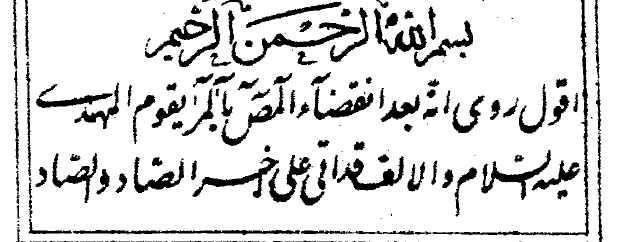

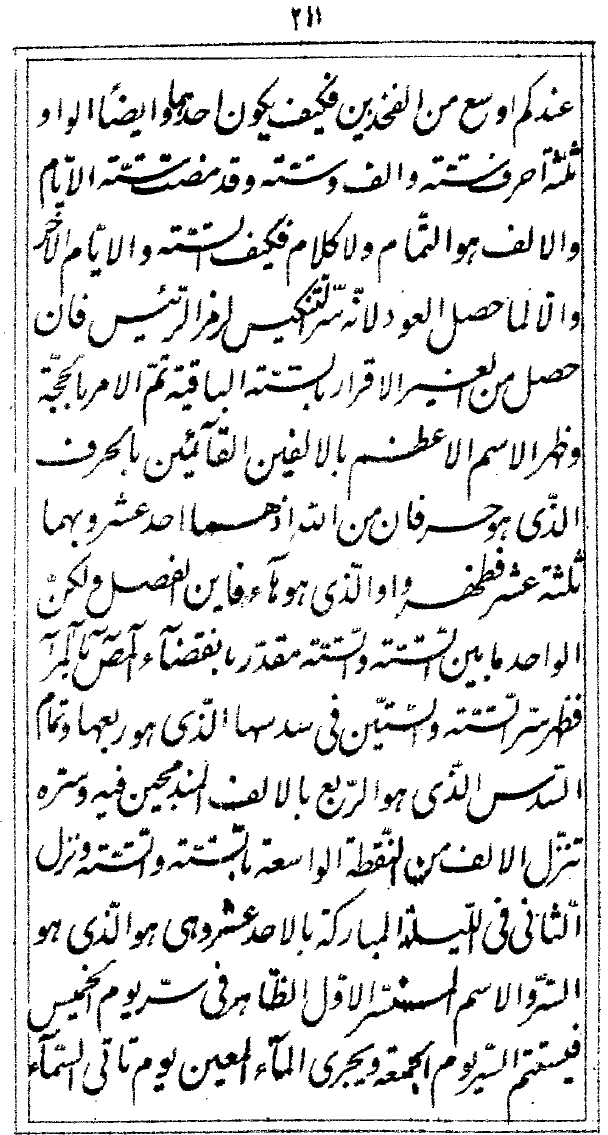
The al-Ahsa'i text as printed in Majmu`ah Alwah-i Mubaraka, pp. 85-86

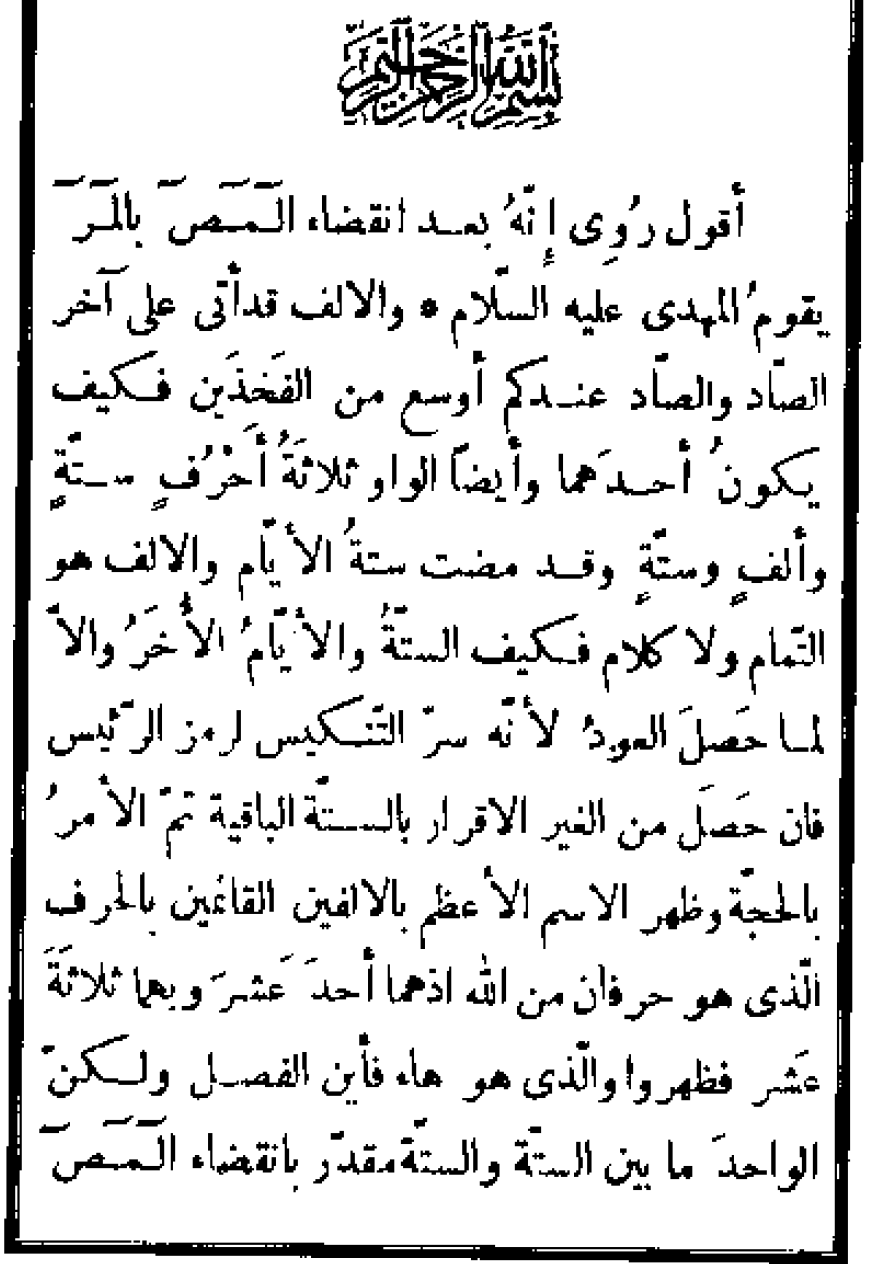
Annotated Beta Translation - 1980s + revised February-March 2022
See al‑Aḥsā’ī, al-Risāla al-rashtiiya in Jawāmi` al-Kalim 1273/6.) esp. 1:103f; Majmū`at al-rasā'il (Kirmān, n.d.), pp. 51-3. cf.also Ishrāq Khāvarī, Qāmūs-i Iqan IV:1642f.
![]()
اقول روی انّه بعد انقضاء المص بالمر يقوم المهدی عليه السّلام
"I [Shaykh Aḥmad al-Ahsa'i] state [in reply] what has been transmitted [from one of the twelver imāms], "After the realization of [the Qur'anic isokated letters] A‑L‑M‑S* (alif‑lām‑mīm‑sād in Qur'an.7) through [the Qur'anic isokated letters] A‑L‑M‑R (alif‑lām‑mīm‑rā’ in Qur'an 13) the Mahdī [Qā’im] ‑‑ upon him be peace‑‑ shall rise up".
The above Imami Shi`i tradition is also cited in the Lawḥ al‑ḥurūfāt al‑muqatta`āt (Tablet about the Isolated Letters ‘ c. 1859 in Mā’idih vol. 4) and in other alwah, scriptural Tablets of Bahā’u’llāh. It is a tradition found in Majlisi’s Biḥār al-anwar and other Shī`ī compilations of tradition and books of tafsīr.
Text and Translation of the Shaykh Ahmad al-Ahsa'i passage continued
و الالف قد اتی علی اخر الصّاد و الصّاد عندكم اوسع من الفخذين
فكيف يكون احدهما و ايضاً الواو ثلثة احرف ستّة و الف و ستّة
"The [letter] "A" (alif) assuredly came at the realization of the [aforementioned letter] S (sād). And the [letter] S (sād) is before you more expansive than the two thighs (awsa`al‑fakhdhāyn) [perhaps the two letter w’s in the fully spelled out letter wāw]. How then could it [the letter "A" merely] be one of the two [thighs = the letter w’s]? Furthermore, [be aware that] the [letter] "W" (wāw) is [spelled with] three letters [1] [having an abjad numerical value of ] six (= w) and [2] [the letter] alif ("A") and [3] six (= abjad w).
The import is that] six "days" have undoubtedly transpired and the [letter] alif (Arabic "A") is the completion (al‑tammām) [of the awaited period] such that no [further] word need be uttered! What though is [indicated by] the [second] six (= w)? It is the other [subsequent] "days" (al‑ayyām al‑ukhra). Otherwise, why was there evident a repetition ["return" of the w] (al‑`awd)? Such assuredly resulted through

the mystery of inversion (sirr al-tankis)
on account of the symbol of the Ruler (li‑ramz al‑ra`īs).
And should this repetition [or "return" of the w] be otherwise accounted for the confirmation (al‑iqrār) thereof would be by virtue of the [existence of the] subsequent [remaining] six (= the second w) (al‑sitta al‑bāqiyya). Then would the matter (al‑amr) [still find realization] in the [messianic] Proof (al‑ḥujja = the Qā’im‑Mahdī) and the [personification of] the Greatest Name (al‑ism al‑a`ẓam) would be manifested in the two upright [letter] "A"s (bi’l‑alifayn al‑qā’imayn) through the letter (bi’l‑ḥarf) which is two letters contained within Allāh ) (ḥarfān min Allāh) [1st letter of Allāh = "A" and last letter = "h"]. This since the two [letter A’s] are [indications of] eleven (11 = 1 beside 1 =11) and both [also] indicate thirteen [= abjad aḥad = "one" = 1+8+4 = 13 or abjad 5+6 = huwa= `He is’). Thus was manifest the [letter] wāw (abjad = 6+1+6 =13) which is [also] the [letter] "H" (al‑hā’). Where then is the differentiation [between these two letters; W= 6+1+6 = 13 and "H" = huwa = 5+ 6 =13]? Yet the one (= A) (al‑wāhid) is what lieth betwixt the six (= w) completion of [the abjad value of the isolated letters?] A‑L‑M‑S* (alif‑lām‑mīm‑sād (Qur'an 7 = abjad 161) through A‑L‑M‑R (Qur'an 13 alif‑lām ‑ mīm‑rā’ = abjad 231 Quran 13 ). Thus is apparent the mystery of the six [=wāw]....
![]()
"I omit several very abstruse lines here of the text of the Risāla al‑Rastiyya as cited by Bahā’u’llāh. He continues, among other things, to indicate that the omitted sentences relate to aspects of the relationship between the numbers 6 and 60 and the letter "A". This passage of Bahā’u’llāh‑Shaykjh Aḥmad concludes after a few further untranslated senmtences (see MAM:87; cf. MacEoin, 1982 [94]:147).
Everything of the foregoing is [indicated] in the [letter] wāw (w) which is upturned [inverted] from the [letter] "H" which is (al‑mankūsa min al‑hā’)...
A Note on the al-waw
![]()
Here Shaykh Aḥmad appears to indicate that the Qā'im (= the alif or letter "A") will appear at the end of the era or cycle of the six days of creation as their ultimate goal or completion. This is the era of the six "days" or religious cycles commencing "creation". They have been understood to signify the prophetic missions of the often six, and variously identified, pre-Islamic prophets "endowed with constancy" (ulū al-`azm cf. Qur'ān 46:34; namely,
- [1] Adam, [2] Noah, [3] Abraham,
- [4] Moses, [5] Jesus and [6] Muhammad = six prophetic dispensations.
On the various interpretations of the Qur'ānic phrase ulū al-`azm Muhammad Baqir Majlisī, Bihār al-anwar 2nd ed. 1:34ff.
It may also be that the final letter "W" (wāw) (of ) or the "(other) six" has to do with the `other days' or era of the eschatological "return" (raj`ah); hence the inverted backward stretching "W" (wāw) in the graphic form of the "greatest name of God" representation (see above) The eschatological "return" (raj`a) of past peoples is alluded to. Such at least may be something of the meaning of al‑Aḥsā'ī.
Sayyid Kazim al-Husayni al-Rashti (d.1259/1843) on the inverted letter waw
A Further Note on the Bahā'ī interpretations of the sirr al-tankīs, 'The Mystery of Reversal"
Bahā'ī interpretations of the sirr al-tankīs to some extent draw on, though they often go beyond, those which appear to have been envisaged by Shaykh ...
The final Arabic and Persian section of the Lawh-i Qina' as printed in Iqtidarat, 212 and Majmu`ah Alwah-i Mubaraka, p. 86-87


Typed text of the final Arabic-Persian paragraphs of Baha'u'llah:

Lambden Beta Translation
We testify that every one of these words (kalimat) [of Shaykh Ahmad al-Ahsa'i from the Risala Rashtiyya] are precious pearls (al-durriyyat)... within then is the water of life (ma' al-hayat). Concealed-veiled therein is the Youth of Mystic meaning and Exposition (ghulam al-ma`ani wa'l-bayan). No seeking wayfarer (sayyarat al-talab) can possibly attain thereto unless they dig especially deep into the well of their enquiry and enable to emerge therefrom the Youth of Knowledge (ghulam al-`ilm). Then shall they exclaim: "Blessed be God! for in His grasp is the very Kingdom of Gnosis [Knowledge] (malakut al-`ilm). He is indeed the One All-Encompassing (al-muhit) of all things [everything[ (kull shay')!
Wherefore do We [again] testify that every letter of this treatise [of Shaykh Ahmad] is assuredly a Glass (la-zujaja) [cf. Q.24:35] from which radiateth forth the Lamp of Knowledge and Wisdom (siraj al-`ilm wa'l-hikmat) ... ...



